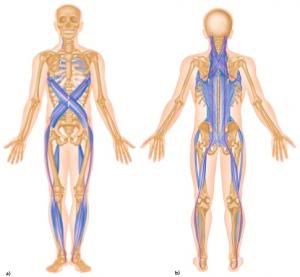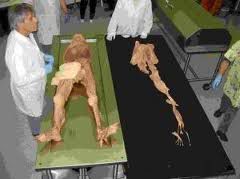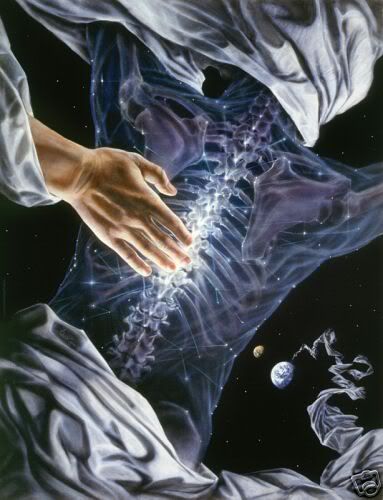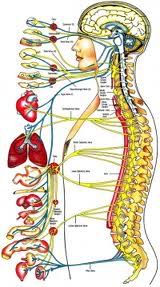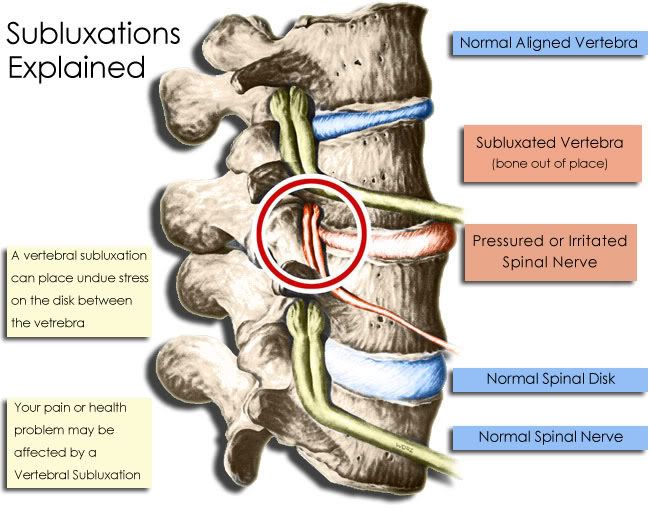Some of you guys have been treated by me lately and I have been talking about myofascial lines. I try to explain it to you, and you shake your head "yeah" but have a glassy look in your eye. Its OK it took me a while to grasp it also. Because we are always taught each specific muscle and thats about the gist of it. Well I found this article in Mens Health that actually started my shift in how I treat, thought I would share it with you. GREAT STUFF
Everything You Know About Muscle is Wrong
Discover the secret to building a stronger, faster, more athletic body
Reported by: Christopher McDougall, Photographs by: Craig Cutler
It's horrifying. Right in front of me, a gorgeous young woman named Andria has slipped out of her clothes and is transforming herself into...me. She's removed her shirt and her black
capris. Now she shakes out her blonde bob and stands in her sports bra and panties, a hand on her slender hip, looking like Brandi Chastain about to hit the showers after practice.
Until... "Head, anterior shift," a woman nearby calls out. She checks her clipboard. "With a posterior tilt."
Andria juts her neck like a tortoise, and then lifts her chin. "Shoulder girdle -- anterior tilt," adds James Ready, a trainer for the Arizona Diamondbacks.Obediently, Andria hunches her back, as if she's been punched in the gut.Four people surround Andria. They're holding clipboards with anatomical sketches and hand-scrawled notes snapped to them. We're in a sports training studio in Tempe, Arizona, for a seminar on the new science of strength, an event focusing almost entirely on human connective tissue. Until recently, very little was understood about these elastic wrappings that surround your muscles and bones. But a series of research breakthroughs now reveals that they might be your body's greatest untapped resource for improving the efficiency of your muscles and preventing injuries.
At this moment I'm receiving a firsthand lesson in elastic power, as the four members of my working group continue to feed instructions to Andria. Suddenly, they order her to freeze.
"Perfect!" one of the women says. Then she turns to me. "That's you."
"You to a T," Ready agrees.
Before the session with Andria, they'd assessed my posture. I'd come in with nagging heel pain, but as they eyed me up and down, that was the one part of my body they ignored.
Pain and power, they believe, are all about posture. Unfortunately, so is pride. During my assessment, I'd done my cheating best to throw my shoulders back and stand tall. But now
as I look at my reflection in Andria's body, I can see that my muscles had no chance against the steady pull of my elastic tissue. One of her shoulders is caved, her head juts like a
Neanderthal's, her hips are crooked. I'm still not sure what that has to do with my heel, but even though she's the one in her underwear, I've never felt more naked in my life.
What's so special about muscles, anyway?
That's what Thomas Myers, who's leading the seminar, wonders. Myers is the author of Anatomy Trains and a top expert in the field of connective tissue. He's been exploring muscle
manipulation and human movement for more than 30 years, traveling the world on an academic odyssey that has allowed him to study under giants in the field. He's also been
personally tutored by Ida Rolf, Ph. D., and Moshe Feldenkrais, Ph. D., who were pioneers in human structural studies, and even Buckminster Fuller, the architectural genius whose
engineering designs contributed to a new understanding of human movement.
Myers became a master of Rolf's technique of manipulating soft tissue (a.k.a. Rolfing) in order to release blockages and allow greater range of motion of the joints and muscles. But
once he got a knife in his hands, he was able to take his mentor's work one step further. As he was assisting in a dissection, he became intrigued by the "rubbery gunk beneath the
skin," as he describes it. The anatomists he was working with were slicing right through it because they wanted a good, unobstructed view of the Kagan McLeod ( i l lust rat ions)
muscle underneath. But there was a lot more gunk than muscle, and cutting through it wasn't easy. In fact, this fascia profundis was everywhere. In some places it sheathed the
muscle like the gooey film around a chicken breast. In others, like the abdominal area, it was woven in and around the muscles like netting. Think of your rectus abdominis, or
six-pack muscle: The fascia is what separates and connects each of its ice-cube-shaped segments.
Maybe, Myers thought, the fascia profundis is more than just a condomlike casing that helps keep bones and muscles in place; maybe all that tensile strength is a source of power in
its own right. There was only one way to find out. In examining the fascia linking the muscles below the profundis layer, "all I had to do was turn my scalpel sideways," Myers recalls.
Instead of slicing through the gunk, he sliced along it, gently freeing it from the bone. He found that even though each individual muscle had a starting and ending point, the fascia
kept going. Think of sausages: Each link (a muscle group) is wrapped in casing (fascia) that stretches to the next link, creating a long, connected chain. By the time Myers finished
slicing, he was looking at a full-length body sleeve that resembled a lumpy wetsuit. As he examined it more closely, he was intrigued to see that the flesh suit wasn't simply one slick
sheet of tissue; it was more like a webbing of crisscrossing fibers, strands, and cables, all interconnected like complex pulleys around levers of the bones.
What if everything we thought we knew about muscles was wrong? Myers thought. Does the body even think in terms of individual muscles? Are there really 600 muscles, or is there
only one? Biologists had examined fascia tissue before, of course, but they generally considered it little more than a mixed assortment of support straps and packing material -- the
body's version of tarps and bungees. But Myers's twist-of-the-scalpel technique demonstrated that the link between muscle and connective tissue was more like a series of very
specific straight and spiral lines that run from foot to forehead and back again.
For example, one line of fascia tissue crisscrosses your abdomen and drops over your hip and down your shin to your foot, where it loops under your arch like a stirrup. Meaning?
The angle of your pelvis affects the strength of your arches. Similarly, your thumbs are ultimately connected to your pecs by fascia. Which is why Myers says that people who
frequently use a PDA in a slumped posture are setting themselves up for problems. (See Beware the BlackBerry Syndrome)

Fascia is also a key part of LeBron James's ability to take flight. While everyone's eyes are focused on the ball in his outstretched hand, an eye trained in the functions of elastic
tissue recognizes that all the other tiny details of his classic slam-dunk pose are just as important. Notice the way his trailing arm stretches wide behind his body; how the toes of his
lead leg point upward and the fingers of his idle hand splay wide. They're all part of his blast off the paint, not as coincidence, but as tiny adjustments that make a big difference in
overall performance.
It took a while for technology to catch up with fascia theory, but by 2007, researchers were able to thread ultrasound sensors into living humans to watch what happens in real time
when, for instance, a weightlifter explodes upward from a squat. "In the classical model, you'd expect the muscle fibers to shorten, the calf muscles to pull on the Achilles tendons,
and the fascia to remain passive," Myers explains. "But the fascia actually recoils, allowing you to use far more of the force you generate than would be otherwise possible." That's
why when you rifle a fastball, the size of your muscles is rarely the most important factor. You want to lengthen your range of rubbery, fascia motion to develop better recoil.

For example, take Tim Lincecum, the 5'11", 170-pound all-star pitcher for the San Francisco Giants. It's likely his ability to maximize fascial recoil that allows him to hurl a baseball at has
traveled to the U.K. to present his latest findings. Recently, Schleip made a startling discovery: Fascia isn't just a bunch of rubbery cables, but actually sensory organs packed
upwards of 100 mph, despite his relatively slight build.
"For many people, fitness is still all about lifting weights to build bulk," Myers says. "But what does that make you fit for? I'd argue that this . . ." -- he taps a key on his laptop and
brings up a slide -- "is a much more physically fit human than a bodybuilder is." On the screen is a photo of a baby boy rolling on his back, blissfully drinking a bottle that he holds with
his feet. Cute, sure; but more important, the little nipper is limber, balanced, and able to match impulse with action. "You are fit if you can adapt to the demands of your environment
with ease and imagination," Myers says.
That kind of thinking recently led the Arizona Diamondbacks to revamp their strength and conditioning program, says James Ready, the trainer in the Diamondbacks system who has
already begun employing Myers's fascia approach. "These days, our big emphasis with weights is about posture, not big plates," Ready says. He has also reassessed the way he
diagnoses injuries. "I've had to step back and take a deeper look at everything I learned in school. We were taught to find the point of pain and treat it. But take hamstring injuries; the
hamstring is usually just the smoke. You have to look elsewhere for the fire."
Power and pain, in other words, are often generated far from their exit points. A fastball leaves your hand at 70 mph, but that speed was generated much farther up your elastic-tissue
chain. Maybe the same was true for my mysteriously throbbing heel; maybe it wasn't falling apart, but was being torn apart by pressure from other parts of my body. My heel was the
scene of the crime, but the perpetrators were hidden somewhere else far away.
You might liken it to the old song about ankle bones connecting to leg bones, leg bones connecting to knee bones, and so on. It's the same with your muscles. Ultimately, they're all
connected -- from head to toe -- by your fascia. So a tight muscle in your foot could cause a chain-reaction pull that leads to tighter hamstrings. And vice versa.
Recently, biomechanics researchers at the University of Calgary reached that same conclusion. The scientists found that most running injuries, which occur below the knee, are
caused by what's above the knee. After reviewing 28 years of studies, they determined that the most likely culprit for an aching arch or a strained Achilles tendon wasn't the foot or the
knee, but the hip. That same idea was tested as far back as 2000, when Michael Fredericson, M. D., a professor of orthopedics and sports medicine at Stanford, decided to treat 24
runners who had sore knees by focusing exclusively on their hips. The results? Six weeks later, 22 of the runners were cured.
"Exactly," Myers says. "Don't punish the victims. Chase the criminals."
IN PURSUIT OF MY TRUE CRIMINALS, I go to London to find the man who, even more than Myers, is the world authority in all things elastic. Robert Schleip, Ph. D., head of the
Fascia Research Project at Germany's Ulm University, with nerve endings. In fact, the fascia is as rich in sensory input as your tongue and eyes are, Schleip found. The upshot:
Fascia isn't just taking orders, it's also issuing them. It reacts to your environment and ultimately creates what Schleip calls "structural compensation." The mechanism works like this:
Every move you make is a physical experiment. If the experiment works -- say, you swish a jumper while cocking your head to the side -- it becomes a habit. All those little habits
become locked in as posture. Over time, posture becomes structure: The man who accidentally nailed a three while his ear was itchy now feels comfortable only when his head is
slightly off kilter.

"Connective tissue is the Saint Bernard dog of the body -- it's slow and loyal," Schleip says. "Once it's formed into position, it'll stick there." (See Is Your Job Ruining Your Body?)
You can contort all you want in search of that mythical ideal alignment, but the odds are against you. The pull of your fascia is so ingrained in your movements, your friends can
recognize you instantly at a distance before they even see your face. Making some kind of fundamental shift in those movement patterns is unlikely, at least in the short term. So if
you can't make the fascia instantly obey, what's the alternative to injury?
"Easy," Schleip says. "Recruit one movement to enable another. Instead of straining to loosen a major fascia and muscle area, loosen a minor one instead."
To demonstrate, he has me stand up and try lifting my right knee until I can grab my foot with both hands. I make it only halfway before I'm tense and wobbling.
"Now grab your knee and swing your leg around," Schleip says. I lift my knee to waist height, grip it with both hands, and swirl my entire thigh for a few rotations. Then I try grabbing
my foot again. This time it comes up easily. "You just loosened the minor fascia around the hip-joint capsule," he says. "You've increased the range of motion in your hamstring
instantly, without stretching or working the muscle at all." If you've ever watched a cat yawn or a horse stiff en its rear legs, you're watching the same kind of joint extension in action.
"That's why you feel such a feeling of satisfaction after yawning. You just popped a few joints loose."
But the real trick is learning how to stop fighting criminals and start putting them to work. For that, you need the real experts.
Old guys and kids.
"The old-timers knew what was up with fascia long before we even had a word for it," says Steve Maxwell, a former world champion Brazilian Jiu-Jitsu fighter who is now a strength
and conditioning coach and an international authority on kettlebell workouts. "You'll always be safe if you go back to the mighty men of old, the guys before the 1950s. Look at the old
gyms, with their Indian clubs and medicine balls. What's that all about if not balance, range of motion, being fluid, using elastic recoil?"
Maxwell learned most of his fascia-based training from old fighters, who in turn learned it from children. One way of seeing if a movement has its roots in the body's natural structure
is to see if kids do it spontaneously. Early childhood is the time for checking out the working parts of the human machine, and one thing kids love is elastic recoil. "Jumping, bouncing,
skipping -- it's all free energy that comes from fascia, not muscle," he says. So it's no surprise that fighters who bounce around the ring on the balls of their feet -- like kids -- spend a
lot of time skipping rope. Get that bounce right, and you can pogo-stick around while barely using any muscular force.
To bounce, though, you need balance. Schleip had demonstrated that to me back in London by holding up a long, Slinky-like spring. He clipped his keys to the bottom and set them
bouncing. As long as the keys came up and down in a straight line and a steady rhythm, they rose and fell with no effort. If the spring slanted off to one side, the balance was lost and
the easy bounce died out. So Maxwell's first job is to find that balance by equalizing strength on both sides of the body. "David Akers, the kicker for the Philadelphia Eagles, was
complaining about how sore his left hamstring gets," Maxwell says. "Since he's a lefty kicker, I just had him kick a soccer ball a few dozen times with his right leg, which never gets
any work." Once Akers regained movement on his idle side, his chronically sore hamstring was cured.
JASON ROSS, D.C., C.S. C.S., a strength coach and the official chiropractor for the U. S. bobsled team, uses a similar bit of movement magic to simultaneously treat lower-back
pain and improve a patient's vertical leap. By standing up quickly from a kneeling lunge position (see The Back-Saving Lunge) with your fists and glutes squeezed tight, Ross says,
you activate that long, spiral line of fascia and restore length in your hip flexor muscles, both of which relieve stress on your lower back. Bingo: just like that, pain relief and power in
the same move.
Back at Maxwell's gym, I'm introduced to another trick. The strength coach hands me a rubber band and has me strap it around my fingers just below my fingernails. "Strength is a
skill," he says as I open my hand against the resistance of the rubber band. "In the old days, every Celtic village used to have its 'manhood stone.' You didn't pass into adulthood until
you could move that stone. But it wasn't about brute force; strength was knowing how to use all the tools inside your body." (See The Secret to Superstrength)
I'm mystified by the rubber-band drill, until Maxwell has me drop to the floor for pushups. "It would be stupid to throw an arrow, right?" he says. "Better to use your muscles to pull back
the string and let the string do the work." Likewise, he has me reverse my normal way of doing pushups by pulling myself down toward the floor, with my fingers spread as wide as
they were with the rubber band and my palms mashed hard into the floor. I pause with my chest just over the floor, and then, startling even myself, I pop up easily.
"See?" Maxwell says. "You tightened the spring on the way down, then it popped you right up." Ancient wrestlers used this technique by creating tension in one direction and suddenly
reversing it to control their opponent. It's like a tug-of-war, he says.
The pushups are exhilarating, but my own criminal -- the piercing heel pain that started me on this quest in the first place -- is still in hiding. Despite everything I've learned about
fascia, I haven't figured out how to deal with the big fascia band under my heel. As tiny as the injury seems, it makes every workout so unpleasant that I can barely run or lift
anymore. In fact, it was the same kind of injury that made Tom Pappas, the world champion decathlete, drop out of the Beijing Olympics. I've heard all kinds of advice from therapists,
on everything from orthotics to bizarre notions like taping my shoulder to my hip for 6 weeks, but nothing has made a difference.
"Forget the tape," scoffs Lee Saxby, a trainer for U. K.-based Wildfitness. "Try this instead." He strips the plates off a 12-pound weightlifting bar and has me lift it overhead. "Now do
10 full squats," he instructs. "Slooowly."
The first few reps, I need to shoot a foot back to steady myself. But bit by bit, I get my shoulders squared and my back aligned over my butt. Once I pull off 10 clean reps in a row,
Saxby yells, "Go!"
"Go?"
"Go. Run!"
I drop the bar and take off in a sprint. Instantly, without even thinking about it, I'm up on the balls of my feet, moving lightly and springily. Amazingly, the heel pain vanishes for the first
time in months. It takes me a while to process what has happened, but once I recall the principles of fascia relationships, it also begins to make sense.
Because I was overdeveloped on one side, I wasn't swinging both legs equally. Instead, I was more like a kid on a scooter, with my left leg enjoying a long stride and a quick bounce
off the ground while my right stride was short, stiff , and lagging. That meant all my body weight was torquing back and forth over that dominant right leg.
Saxby's diagnostic eye is excellent: His prescription of deep overhead squats -- a unique exercise that challenges the flexibility of the upper back, shoulders, hips, and ankles --
serves as a total-body therapy that targets my entire muscular system instead of an individual muscle. It forces me to engage my core, divvy up the workload evenly between my two
legs, and temporarily loosen my connective tissue from head to heels. I've been told over and over in the past to stretch my calves, but my heel pain had nothing to do with those
muscles. It was caused by the shortened fascia under my heel and made worse by tightness and posture problems further up the chain. All I needed to loosen it was the one-two
punch of deep squats, and the quick, pitter-pat plyometrics of running on the balls of my feet. By staying off my heel, I'm giving my arch a good, deep bend with every step, stretching
the fascia even more.
It's amazing; I thought it would take weeks to ease my aching heel, but with proper treatment, relief is almost miraculously quick. I'm not totally cured; as Schleip warns, the Saint
Bernard stubbornness of fascia means that it will try to creep right back to its shortened state as soon as I stop running. But that's the beauty of Saxby's treatment. All I need to do is
keep loosening the fascia daily until eventually, it sticks.
Running feels so good, in fact, that for the first time in months, I don't want to stop. I never would have made the connection between deep squats and light strides, I'm thinking as I
run through the streets. On the other hand, I never knew that movement could be its own medicine.
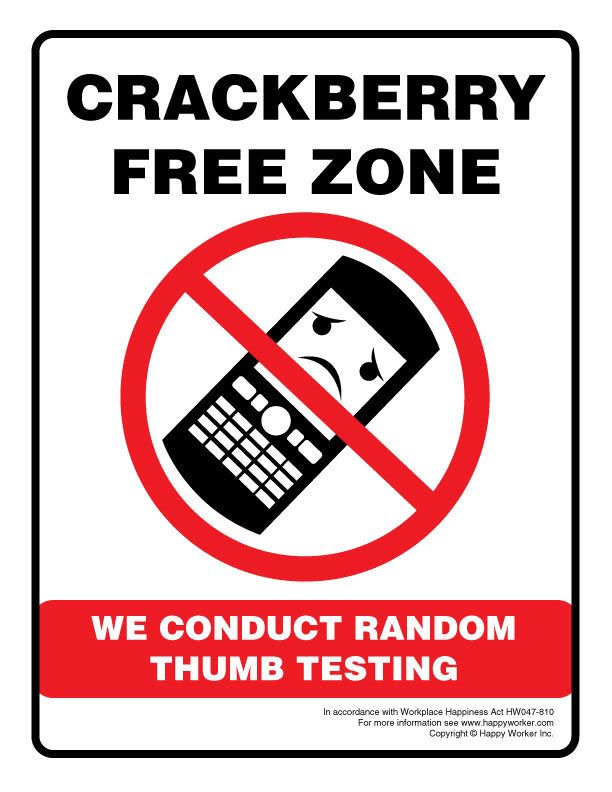
Beware The Blackberry Syndrome
While texting, do you feel a knot in your back or a throbbing in your upper arms? The problem could lie in your thumbs. Because they're the strongest digits on your hands, your
thumbs are anchored by two major strands of fascia. This tissue extends all the way up your arm and around your pectoral minor muscle to your rib cage -- meaning you have a
formidable force pulling against your chest every time your thumbs are at work. If you always hunch over and allow that fascia to shrink and tighten, you're pitting your thumbs against
your chest in a short-rope tug-of-war. So when you text, keep your shoulders pulled back and use these two simple stretches a couple of times a day to help undo any damage.
Stretch 1 Kneel a few inches from a wall with your body in straight line from head to knees. Slide your hands as high up the wall as possible. When you feel the strain, hold for a 10
count, and then slide your hands back down again. Repeat once.
Stretch 2 Stand tall, with your feet shoulder-width apart and knees slightly bent. Link your fingers behind your lower back so that your palms face up. Then, keeping the natural arch
in your lower back, stretch your arms down toward your legs by pressing your shoulders toward the floor and squeezing your shoulder blades together. Repeat once.
Is Your Job Ruining Your Body?
Since most of us spend more hours a day slumped behind a steering wheel or over a keyboard than we do in motion, the way you sit has more influence on your posture than the way
you stand does. Over time, your connective tissue adapts to your slouch, making it your natural posture. Besides giving you the look of a Neanderthal, it can also lead to lower-back
and neck pain, injury-prone shoulders, and a caved-in chest. Make sure that doesn't happen to you: Try these cues for sitting up straight from trainer Rachel Cosgrove, C.S. C.S., a
co-owner of Results Fitness, in Santa Clarita, California. They're not quick fixes, but the perfect-posture rules you need to follow every single day.
Sit as tall as you can Sure, it sounds obvious, but remind yourself every few minutes, whether you're at your desk or in your car. You'll be surprised at how much you tend to slump
when you're not thinking about your posture.
Keep your chest up Pretend there's a string attached from your chest to your ceiling, pulling your chest up at all times.
Pull your shoulder down and back Imagine that you're trying to create as much space between your ears and shoulders as you can. Hold that position.
Tighten your core Brace your abs as if you're about to be punched in the gut -- but breathe normally. It'll seem hard, but keep practicing, and it'll become second nature.
The Back-Saving Lunge
This lunge is great to do any time you've been sitting for a while, or as a warmup exercise before lifting or playing hoops. Stand tall with your feet shoulder-width apart, and take a step
forward with your left leg. Keeping your torso upright, bend your left knee and lower your body until your left knee is bent 90 degrees and your right knee touches the floor. Pause and
steady yourself, and then drive your left heel into the floor and push yourself up and forward. As you're standing up, clench your fists tightly and squeeze your glutes together. Stand
tall and hold the clench for a 5 count. Then lunge forward with your right leg. Repeat with both legs.
The Secret To Superstrength
To fully grasp the catapult power of your connective tissue, think of Bruce Lee's 1-inch punch. Because he knew how to snap his entire body like a rubber band, Lee had the ability to
knock a man flying from an inch away. To learn how to combine your 600 muscles into one, Bruce Lee-style, try these variations of classic exercises, courtesy of strength coach
Steve Maxwell.
Goblet Squat Use both hands to hold a dumbbell vertically under your chin. (Cup it as you would a heavy goblet.) With your feet shoulder-width apart and your body weight back on
your heels, forcefully pull yourself down with your hip flexors into a full squat. Without pausing or releasing tension, explode straight up. "The beauty of the goblet squat is the way it
corrects every bad habit you pick up from sitting in a chair," says Maxwell. "Most men lean forward when they sit, and that movement shows up in their squats. The goblet teaches
balance and clean biomechanics."
Push-Down Pullup "It's amazing how many men can't fully straighten or lock their arms over their heads," Maxwell says. "They've lost all that great power from their fascia by never
completely extending." Grab a pullup bar with a shoulder-width, overhand, thumbless grip. (Wrap your thumbs on the same side of the bar as your fingers.) Hanging with your arms
completely straight, lats tight, and shoulders in their sockets, pull yourself up while exhaling sharply with a hiss. Pull your throat forward next to the bar. When you lower yourself,
imagine you're pushing yourself down instead of letting gravity pull you.
Backward Rope Skips Mastering the rope means learning how to "jump without jumping" -- in other words, drawing on the springiness of your rubbery calves, feet, and ankles to
turn yourself into a human pogo stick. By reversing the rope and spinning it backward, you have the added benefit of balancing your shoulders, opening your chest, and extending
your spine, all of which helps loosen your fascia. "Everything you do in life tempts you to hunch forward," Maxwell says. "So seize those opportunities to pull back and straighten up."
Dr. Tri Myers
Omega Chiropractic Center
107 Edinburgh South Drive, Suite 141
Cary, NC 27511
919-462-0016

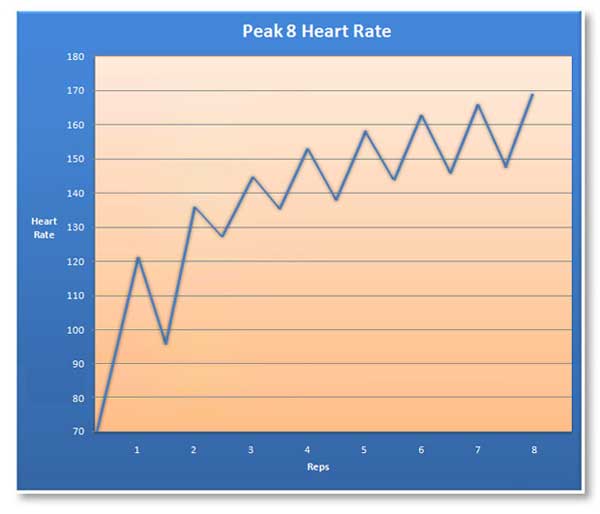 You will certainly want to work your way up to this point, but ultimately you want to exercise vigorously enough so you reach your anaerobic threshold as this is where the "magic" happens that will trigger your growth hormone release.
You will certainly want to work your way up to this point, but ultimately you want to exercise vigorously enough so you reach your anaerobic threshold as this is where the "magic" happens that will trigger your growth hormone release.





